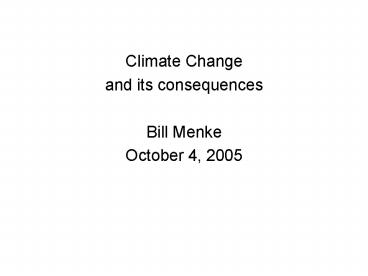Climate Change PowerPoint PPT Presentation
Title: Climate Change
1
- Climate Change
- and its consequences
- Bill Menke
- October 4, 2005
2
Summary
- The factors that influence global temperature
- The role of greenhouse gasses
- Anthropogenic emissions of greenhouse gasses
- Natural Variability and Modeling efforts
- Hazards of increased temperatures
3
- Sunlight mostly visible light
- Maximum 1370 W/m2
- Average 1370 / 4 343 W/m2
- Aboput 30 reflected as visible light
- The rest converted absorbed by earth
- Earths surface gets hot
- and re-radiated energy as Invisible Infrared
radiation
343 W/m2
240 W/m2
103 W/m2
average surface area of earth is 4pr2, but only
a disk of diameter pr2 faces the sun, hence the
average is one fourth of the maximum
4
- 1370 W/m2
- One toaster per square meter
- thats a lot of heat
1370 Watts
1 square meter
5
- Infrared energy radiated by a hot object depends
strongly - upon it temperature
E c T4 With T in Kelvin and c 5.6 x 10-8
W/m2K4
1 square meter
temperature, T
6
- So how hot is the earths surface
240 Watts downward
Balanced by 240 Watts upward
240 5.6 x 10-8 T4
T ( 240 / 5.6 x 10-8 )1/4 255 K -17 deg C
1 deg F
1 square meter
temperature, T
7
- Reality Check ! 255 K is too cold
- We must be doing something wrong ...
New style of summer clothing
8
- We forgot the Atmosphere
Layer just thick enough to absorb all Infrared
radiation that shines upon it
9
- Energy balance
- IR shining into a layer
- Must be balanced by
- energy radiated by layer
10
- Model with two layer atmosphere
- Top of Atmosphere
- upward radiation must balance solar input
- cT04 240 W/m2
Sun 240 down
Top surface 240 up
T0 255K
Bottom surface 240 down
11
- Total energy leaving upper atmosphere
- 2 x 240 W/m2
- Must equal energy received from lower atmosphere
cT14 2 x 240 W/m2
240 up
T0 255K
480 up
T1 304K
240 down
Lower atmosphere must be hotter to balance heat
shining down from upper atmosphere
12
- Suppose you had three layers
cT24 (480 480 240) W/m2
T0 255K
480 up
240 down
T1 304K
720 up
480 down
T2 337K
Lower atmosphere must be hotter to balance heat
shining down from upper atmosphere
13
- The more layers, each just opaque enough to
absorb IR radiation, the hotter the lower
atmosphere is - How many layers in the Earth atmosphere?
- Somewhere between 2 and 3, probably closer to 2
- (well, this is a very simplified model )
14
- What controls the IR opacity of the atmosphere
- The concentration of greenhouse gasses
- Water vapor
- Carbon dioxide
- Methane
- Halocarbons
- Nitrous oxide
15
- How do you compare greenhouse
- Gas concentrations ?
- The effect on the IR opacity is whats important
- Not their actual concentration in the atmosphere
- Standard practice represent as an equivalent
change in solar radiation, radiative forcing
16
Greenhouse gasses have been increasing due to
anthropogenic causese.g. burningfossil fuels
17
(No Transcript)
18
Can future rise in atmosphericCO2 be predicted?
- Sources of atmospheric CO2
- burning fossil fuels
- deforestation
- Sinks of atmospheric CO2
- absorption into ocean
- forest growth
19
Spatial pattern of oceans absorption and
emmission of CO2 is very variable
20
But remember water vapor is the major
greenhouse gas
21
Thats a problem for models of global
warmingconcentration of water vapor very
variablethey are also temperature
dependenthotter climate more water vaporbut
water vapor creates clouds, which increase the
earths albedo
22
The earth is getting hotter
23
(No Transcript)
24
- Is the increase in radiative forcing causing this
global warming n? - And if so
- Will temperatures continue to increase as we
continue to add - greenhouse gasses to the atmosphere?
25
Lesson from the Ice Age global temperature has
been very variable, so Natural variation needs to
be seriously considered
26
Models of climate necessary to sort out
causes But How do you build confidence that
models are correctly predicting the climate
system? Traditional well-controlled experiments
are impractical One approach model the past
27
An attempt to model Last 150 year Temperature
variations Requires both Natural
and Anthropogenic Forcing Note big increase
in Anthropogenic forcing Since 1950
28
(No Transcript)
29
(No Transcript)
30
EXEMPLARY IMPACT SEA LEVEL RISE
Light grey parts of Mississippi Delta that are
less than 5 meters below sea leavel.
31
(No Transcript)
32
Why Sea Level Rise?
- Melting of Glaciers, especially in Greenland and
West Antarctica - Huge effect 7 meters if you melt Greenland alone
- Thermal expansion of ocean waters as you heat
them - Huge effect 1 meter per deg C, if you warmed the
entire world ocean down to the sea floor
33
A very large percentage ofpeople live at low
elevations
34
List of Physical Impacts
- Temperature
- hotter peak temperatures
- fewer really cold days
- hotter nights
- Weather
- more droughts
- more intense wind in hurricanes
- warmer winters
- Precipitation
- more intense rain storms
- more evaporation, less runoff in rivers

